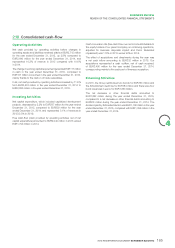APC 2015 Annual Report Download - page 197
Download and view the complete annual report
Please find page 197 of the 2015 APC annual report below. You can navigate through the pages in the report by either clicking on the pages listed below, or by using the keyword search tool below to find specific information within the annual report.
2015 REGISTRATION DOCUMENT SCHNEIDER ELECTRIC 195
CONSOLIDATED FINANCIAL STATEMENTS AT DECEMBER31,2015
5
NOTES TO THE CONSOLIDATED FINANCIAL STATEMENTS
Note1
Accounting Policies
1.1 – Accounting standards
The consolidated fi nancial statements have been prepared in
compliance with the international accounting standards (IFRS)
as adopted by the European Union as of December 31, 2015.
Thesame accounting methods were used as for the consolidated
fi nancial statements for the year ended December31, 2014.
The following standards and interpretations that were applicable
during the period did not have a material impact on the consolidated
fi nancial statements as of December31, 2015:
•IFRIC21– Levies; this interpretation related to the accounting of
taxes under IAS37 provisions scope indicates that the triggering
event for the accrual is the tax due date;
•Annual Improvements to IFRSs 2011-2013 Cycle
(December2013).
Implementation of IFRS10 and IFRS11 led to some changes in
consolidation impact with no signifi cant effect on consolidated
fi nancial statements.
The Group did not apply the following standards and interpretations
that are mandatory at some point subsequent to December31, 2015:
•standards adopted by the European Union:
–amendments to IAS 19 – Defi ned Benefi t plans: Employee
Contributions;
–annual i mprovements to IFRSs 2010-2012 Cycle
(December2013);
–amendments to IAS1– Disclosure initiative;
–annual Improvements to IFRSs 2012-2014 Cycle
(September2014);
–amendments to IFRS 11- Accounting for Acquisitions of
Interests in Joint Operations;
–amendments to IAS16 and IAS38: Clarifi cation of Acceptable
Methods of Depreciation and Amortization.
•standards not yet adopted by the European Union:
–IFRS9– Financial instruments;
–IFRS15– Revenue from Contracts with Customers;
–IFRS16– Leases;
–amendments to IFRS10 and IAS28– Sale or Contribution of
Assets between an Investor and its Associate or Joint Venture;
–amendments to IFRS10, IFRS12 and IAS28– Investment
entities: Applying the Consolidation Exception;
–amendments to IAS12– Recognition of Deferred Tax Assets
for Unrealised Losses.
There are no differences in practice between the standards applied
by Schneider Electric as of December31, 2015 and the IFRSissued
by the International Accounting Standards board (IASB).
The Group is currently assessing the potential effect on the
Group’s consolidated fi nancial statements of the standards not yet
applicable. At this stage of analysis, the Group does not expect
the impact on its consolidated fi nancial statements to be material,
except for IFRS 9 due to uncertainties surrounding the adoption
process in Europe and except IFRS16 for which main effect would
be, in 2019, the inclusion of lease commitments for operating
leases detailed in note13.3 into fi nancial debt.
1.2 – Discontinued operations
On February 5, 2014, Schneider Electric announced that it has
signed an agreement for the sale of the Invensys Appliance division,
because this unit is not a core business to Schneider Electric.
The consideration for the transaction is GBP150 million and
the agreement was completed on June18, 2014. The Invensys
Appliance division was reported as discontinued operations in the
Group consolidated fi nancial statements for the full year 2014.
On October1, 2014 the Group has obtained all required regulatory
approvals and subsequently fi nalized the sale of Custom Sensors&
Technologies (CST) based on an enterprise value of USD900million
(approximately EUR650million). As part of the transaction, the Group
has reinvested approximately USD100 million alongside Carlyle,
PAI and CST management to hold a shareholding of 30% of CST.
CST was reported in the Industry business of Schneider Electric.
The CST activity was reclassifi ed as discontinued operations in
the Group fi nancial statements from January1 to September30,
2014 (for EUR24million net income). From October1, 2014 and for
full year 2015, the 30% CST stake is accounted for by the equity
method.
1.3 – Basis of presentation
The fi nancial statements have been prepared on a historical cost
basis, with the exception of derivative instruments and available–
for-sale fi nancial assets, which are measured at fair value. Financial
liabilities are measured using the amortized cost model. The book
value of hedged assets and liabilities, under fair-value hedge,
corresponds to their fair value, for the part corresponding to the
hedged risk.
1.4 – Use of estimates and assumptions
The preparation of fi nancial statements requires Group and
subsidiary management to make estimates and assumptions
that are refl ected in the amounts of assets and liabilities reported
in the consolidated balance sheet, the revenues and expenses in
the statement of income and the obligations created during the
reporting period. Actual results may differ.
These assumptions mainly concern:
•the measurement of the recoverable amount of goodwill,
property, plant and equipment and intangible assets (note1.11)
and the measurement of the goodwill impairment (note8);
•the measurement of the recoverable amount of non-current
fi nancial assets (note1.12 and note15);
•the realizable value of inventories and work in process (note1.13);
•the recoverable amount of accounts receivable (note1.14);
•the valuation of share-based payments (note1.20);
•the calculation of provisions for contingencies, in particular for
warranties (note1.21);
•the measurement of pension and other post-employment benefi t
obligations (note22).
























